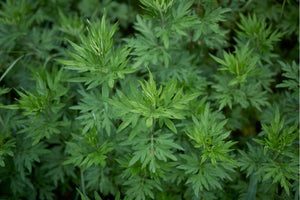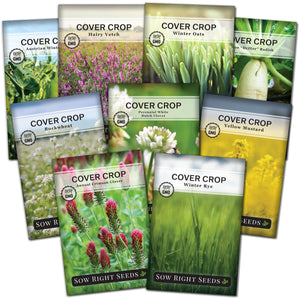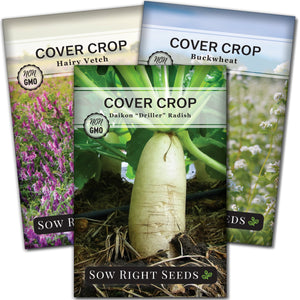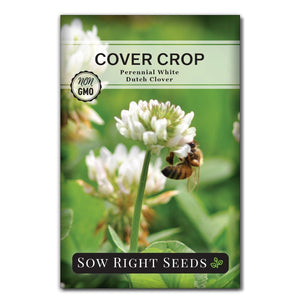Quick, Fast, and Easy: Growing Annual Buckwheat as a Cover Crop
Cover crop growing tipsBuckwheat is an excellent cover crop for the home gardener. It's quick-growing and does well in poor soils. Learn when and how to plant seeds to take advantage of all the benefits of buckwheat as a cover crop.

6 Benefits of Buckwheat as a Cover Crop
1 - Quick Soil Cover
If you need something that grows quickly in case of an emergency, buckwheat will perform well. Buckwheat’s seeds germinate in three to five days, making it one of the fastest cover crop options available.
2 - Weed Suppression
Warm-season annual weeds don’t stand a chance against the quick growth and shade of buckwheat. Cover your garden in buckwheat when you want to eliminate weeds between crop cycles.
3 - Loosens Topsoils
Buckwheat has plenty of fine roots that can break up and condition the soil, perfect for getting the soil ready for fall crops. Combine buckwheat with driller radish for a clay soil amendment.
4 - Scavenges Phosphorus
Buckwheat is much more efficient at this process than other cereal covers. Its fibrous root clusters take up phosphorus (and other nutrients) and produce mild acids to release these nutrients into the soil. As the residue from buckwheat’s green manure breaks down, these nutrients become available to later crops.
5 -Nectar for Pollinators and Beneficial Insects
When buckwheat flowers, it has beautiful white blossoms. The nectar-filled blooms attract bees, lady beetles, and other beneficial insects. These insects help control aphids, mites, and other pest populations.
6 - Rejuvenator for Low-Fertility Soils
Buckwheat outperforms cereal grains on low-fertility soils or soils with high levels of organic matter and can be used to replenish over-farmed soil and cleared land.
Planting Buckwheat as a Cover Crop
Buckwheat is a fast-growing broadleaf crop that is excellent as a cover crop for the home gardener. It does well in poor soils and reaches maturity in 70-90 days. The residue breaks down quickly for green manure. It is not bothered by most pests or diseases, so no extra pest management is needed.
- Sow buckwheat seeds any time from late spring to late summer.
- Cultivate the soil bed and broadcast seeds, tamping down firmly.
- Water the seeds and keep the soil moist until they germinate.
- Once the seeds have sprouted, keep the soil moist but not saturated. Buckwheat does not tolerate wet roots.
- You can turn buckwheat under at any time for green manure.
Even though buckwheat does well in cool conditions, it is not frost-hardy and is not well adapted to winter growing. It also fares poorly in hot, dry conditions, so we recommend it for a short-season cover, especially in midsummer.

Growing Buckwheat for Food
Buckwheat can be raised as a food crop in addition to a cover crop. It is a pseudocereal (along with amaranth and quinoa) that isn’t technically a grain, but its seeds are used for flour and other uses. Because of its quick crop cycle, it can be double-cropped if planted in early summer in most areas.
Hulled buckwheat, or groats, can be boiled and eaten whole as a healthy porridge called kasha. Kasha is widely eaten in Asia and elsewhere. In addition, ground groats can be used as nutritious gluten-free flour and are commonly used in pancakes, noodles, and other dishes.
Leftover buckwheat hulls are also sometimes used as fill for pillows, especially in Japan.
Buckwheat groats are ready to harvest when 80 to 90% of the seeds have turned brown.

When to Cut Buckwheat Cover Crops
The drawback of growing buckwheat as a pollinator habitat or as a food crop is the risk of reseeding. If you wait too long, some of the seeds will escape and scatter into the soil. To prevent buckwheat from becoming invasive, mow about 7 to 10 days after flowering begins, well before seeds begin to harden. The residue can be left on the surface or turned back into the soil.
Buckwheat is an easy, quick-growing cover crop for soil protection and weed suppression and can easily be prevented from becoming invasive with a little bit of care. We especially recommend it for use during those times when you’ve had a crop failure or planting has been delayed because of weather or other emergencies. It pairs well with red clover for maximum soil conditioning and replenishment.
Add quick-growing annual buckwheat to your crop rotation. It will improve your soil, provide nectar for pollinators, and suppress weeds. See the difference a buckwheat cover crop can make in your garden.
More Resources :
- SARE.org - Buckwheat
- eorganic.org - Buckwheat for Cover Cropping in Organic Farming
- Oregon State Extension - Buckwheat makes a good summer cover crop for gardens
- University of Hawai'i Extension Service - Buckwheat
Written by Teresa Chandler









Leave a comment